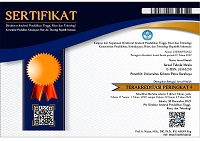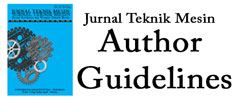Increase of Performance and Smoke Emission by Increasing ERG Rate in IDI Diesel Engine using Jatropha Oil and Diesel Fuel Blends
Keywords:
EGR rate, EGR temperature, performance, smoke emissions, jatropha oil and diesel fuel blendsAbstract
Recently, a study of biodiesel fuel use as a substitute of diesel fuel becomes an interesting topic due to critical fossil fuel availability. The use of biodiesel fuel directly into diesel engine without the change of fuel injector parameter causes the problems because of different properties of biodiesel fuel compared with that of diesel fuel. The aim of present study is to investigate experimentally the effect of exhaust gas recirculation (EGR) on the diesel engine performance and smoke emissions by using jatropha oil and diesel fuel blends as the fuel. EGR is one of methods to increase the fuel efficiency of diesel engine. The use of EGR method on diesel engine may also reduce NOx emissions. In this research, EGR temperature is varied to study its effect on the diesel engine consumption and smoke emissions. Jatropha oil blend is in the range of 10 to 30 %. It is found that the high EGR rate expressed the low fuel consumption compared with that of the low EGR rate by using diesel fuel or jatropha oil - diesel fuel blends. The present paper also shows that the high EGR rate results the high smoke emissions for both cases.References
Husberg, T., Gjirja, S., Denbratt, I., and Eng¬ström, J., Visualization of EGR Influence on Diesel Combustion with Long Ignition Delay in a Heavy-Duty Engine, SAE International, USA, 2004.
Risberg, P., Kalghatgi, G., and Ångstrom, H., The Influence of EGR on Auto-ignition Quality of Gasoline-like Fuels in HCCI Engines, SAE International, USA, 2004.
McTaggart, G.P., Bushe, W.K., Rogak, S.N., Hill, P.G., and Munshi, S.R., The Effects of Vary¬ing EGR Test Conditions on a Direct Injection of Natural Gas Heavy-Duty Engine with High EGR Levels, SAE International, USA, 2004.
Tao, F., Liu, Y., Bret, H., Ewert, R., David, E., Foster. R., Reitz, D., Choi, D., and Miles, P.C., Modeling the Effects of EGR an Injection Pres¬sure on Soot Formation in a High-Speed Direct-Injection (HSDI) Diesel Engine Using a Multi-Step Phenomenological Soot Model, SAE Inter¬national, USA, 2005.
[Zhu, J., andLee, K., Effects of Exhaust Gas Recirculation on Particulate Morphology for a Light-Duty Diesel Engine, SAE International, USA, 2005.
Pariotis, E.G., Hountalas, D.T.,and Rako¬pou¬los, C. D., Modeling the Effects of EGR on a Heavy Duty DI Diesel Engine Using a New Quasi-Dimensional Combustion Model, SAE Inter¬national, USA, 2005.
Avinashet, K.A., Shrawan, K.S., Shailendra, S., and Mritunjay, K.S., Effect of EGR on the exhaust gas temperature and exhaust opacity in compression ignition engines, Sadhana Vol. 29, Part 3, June 2004.
Gogoi, T.K., and Baruah, D.C., A cycle simula¬tion model for predicting the performance of a diesel engine fuelled by diesel and biodiesel blends, Energy, 2010.
Amit, S., Rajneesh, A., Singh, N.P., Rakesh, S., and Malhotra, R.K., Blends of biodiesels synthe¬sized from non-edible and edible oils: Influence on the OS (oxidation stability), Energy, 2010.
Mani, M., Nagarajan, G., and Sampath, S., Characterisation and effect of using waste plas¬tic oil and diesel fuel blends in compression ignition engine, Energy, 2010.
Downloads
Published
Issue
Section
License
Jurnal Teknik Mesin diterbitkan oleh Universitas Kristen Petra.
![]()
Artikel dan semua materi yang diterbitkan terkait didistribusikan di bawah Lisensi Internasional Creative Commons Attribution License (CC BY).


















